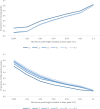AdductHunter: identifying protein-metal complex adducts in mass spectra
- PMID: 38321500
- PMCID: PMC10845562
- DOI: 10.1186/s13321-023-00797-7
AdductHunter: identifying protein-metal complex adducts in mass spectra
Abstract
Mass spectrometry (MS) is an analytical technique for molecule identification that can be used for investigating protein-metal complex interactions. Once the MS data is collected, the mass spectra are usually interpreted manually to identify the adducts formed as a result of the interactions between proteins and metal-based species. However, with increasing resolution, dataset size, and species complexity, the time required to identify adducts and the error-prone nature of manual assignment have become limiting factors in MS analysis. AdductHunter is a open-source web-based analysis tool that automates the peak identification process using constraint integer optimization to find feasible combinations of protein and fragments, and dynamic time warping to calculate the dissimilarity between the theoretical isotope pattern of a species and its experimental isotope peak distribution. Empirical evaluation on a collection of 22 unique MS datasetsshows fast and accurate identification of protein-metal complex adducts in deconvoluted mass spectra.
Keywords: Constraint integer optimization; Dynamic time warping; Mass spectrometry; Protein adducts.
© 2024. The Author(s).
Conflict of interest statement
The authors declare that they have no competing interests.
Figures





References
-
- Ferrige AG, Seddon MJ, Jarvis S, Skilling J, Skilling J, Aplin R. Maximum entropy deconvolution in electrospray mass spectrometry. Rapid Commun Mass Spectrom. 1991;5(8):374–377. doi: 10.1002/rcm.1290050810. - DOI
-
- Ferrige AG, Seddon MJ, Green BN, Jarvis SA, Skilling J, Staunton J. Disentangling electrospray spectra with maximum entropy. Rapid Commun Mass Spectrom. 1992;6(11):707–711. doi: 10.1002/rcm.1290061115. - DOI
-
- Hartinger CG, Ang WH, Casini A, Messori L, Keppler BK, Dyson PJ. Mass spectrometric analysis of ubiquitin-platinum interactions of leading anticancer drugs: MALDI versus ESI. J Anal At Spectrom. 2007;22:960–967. doi: 10.1039/B703350H. - DOI
LinkOut - more resources
Full Text Sources

